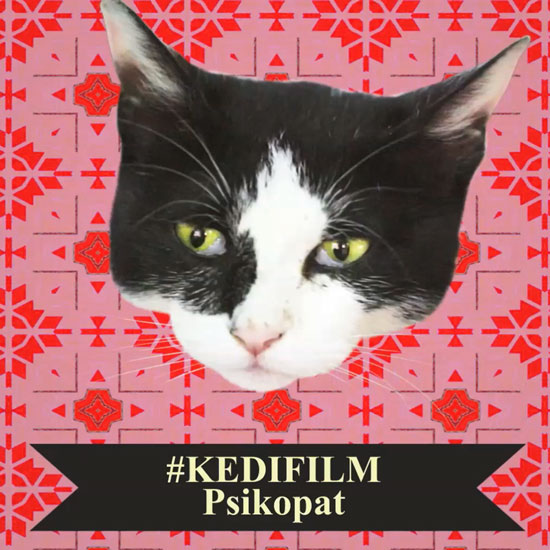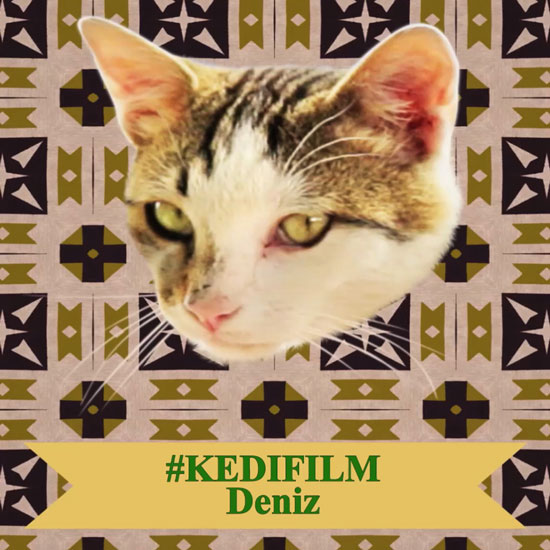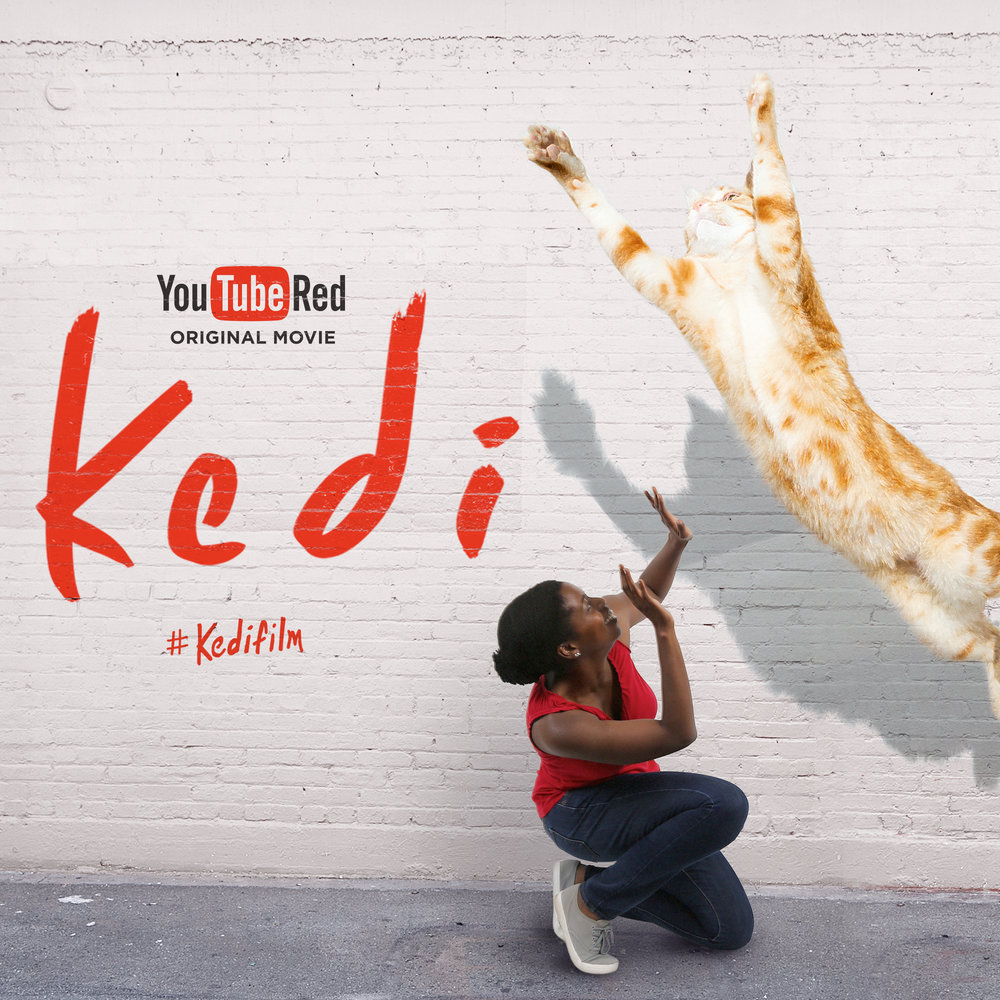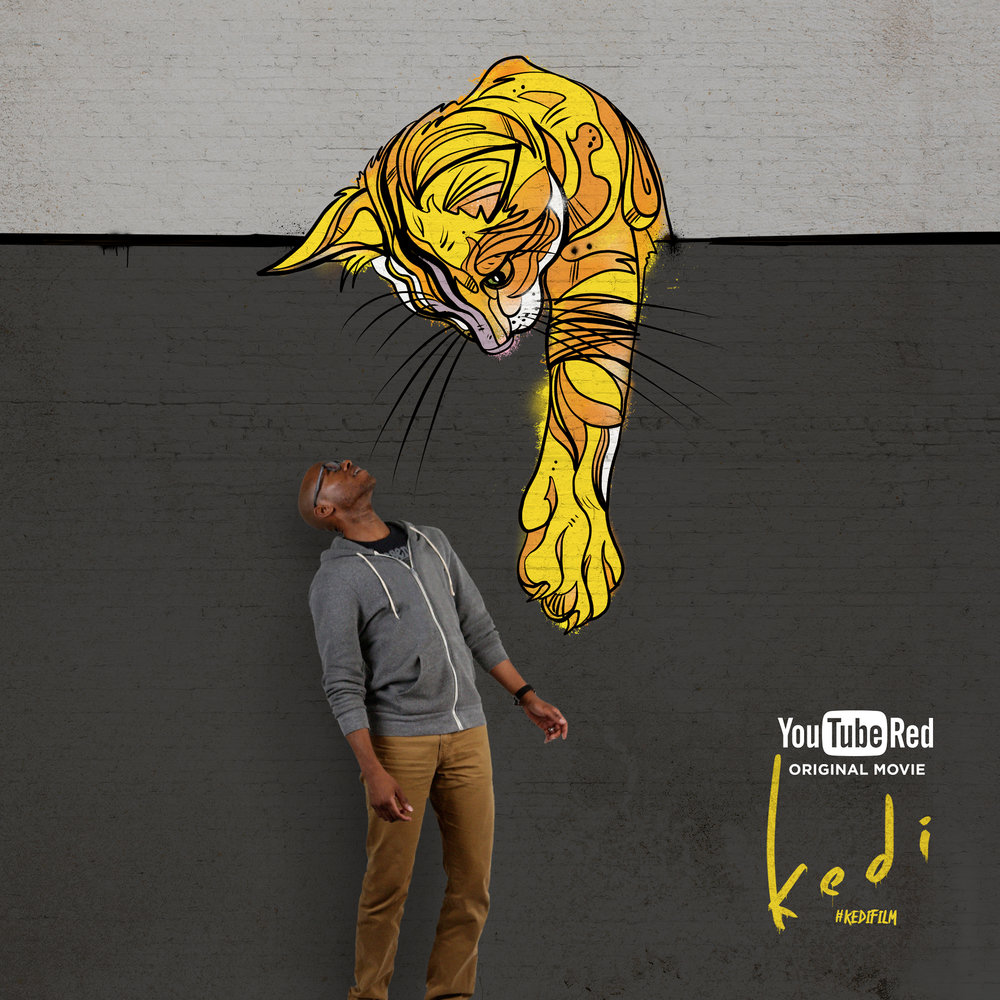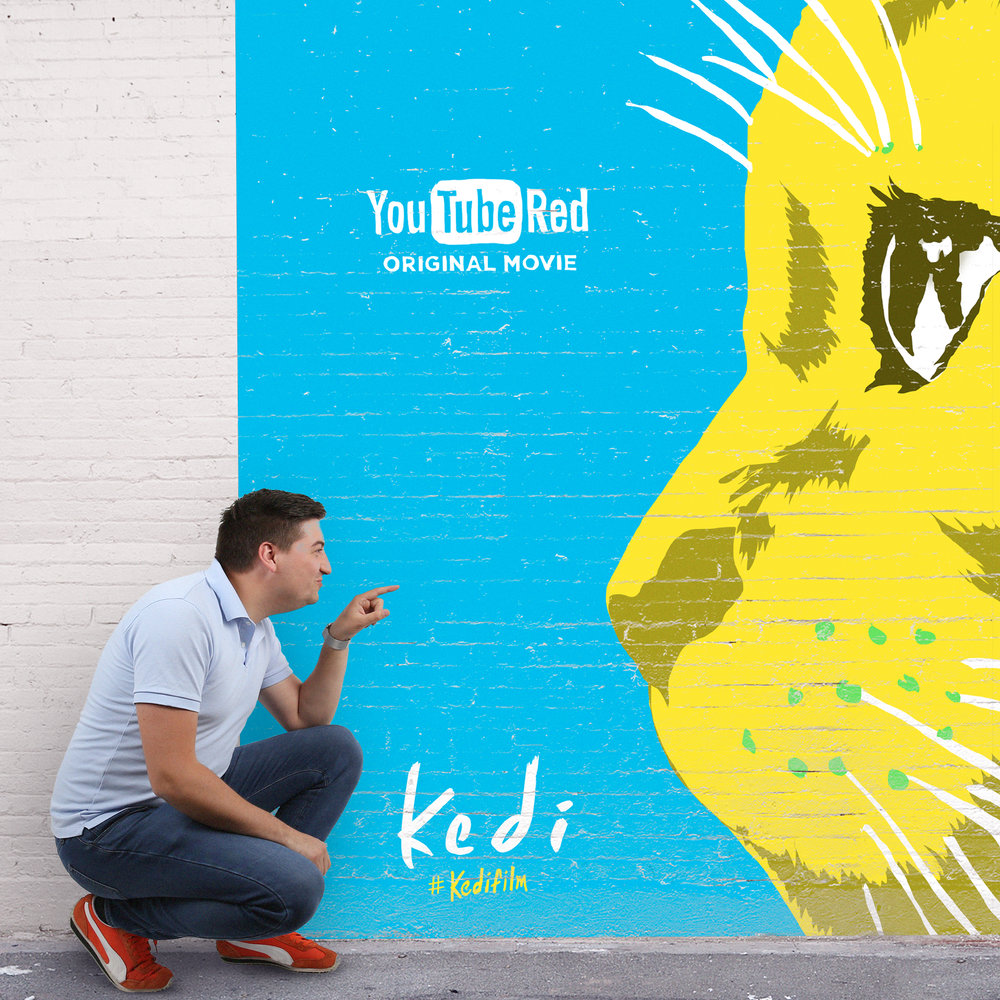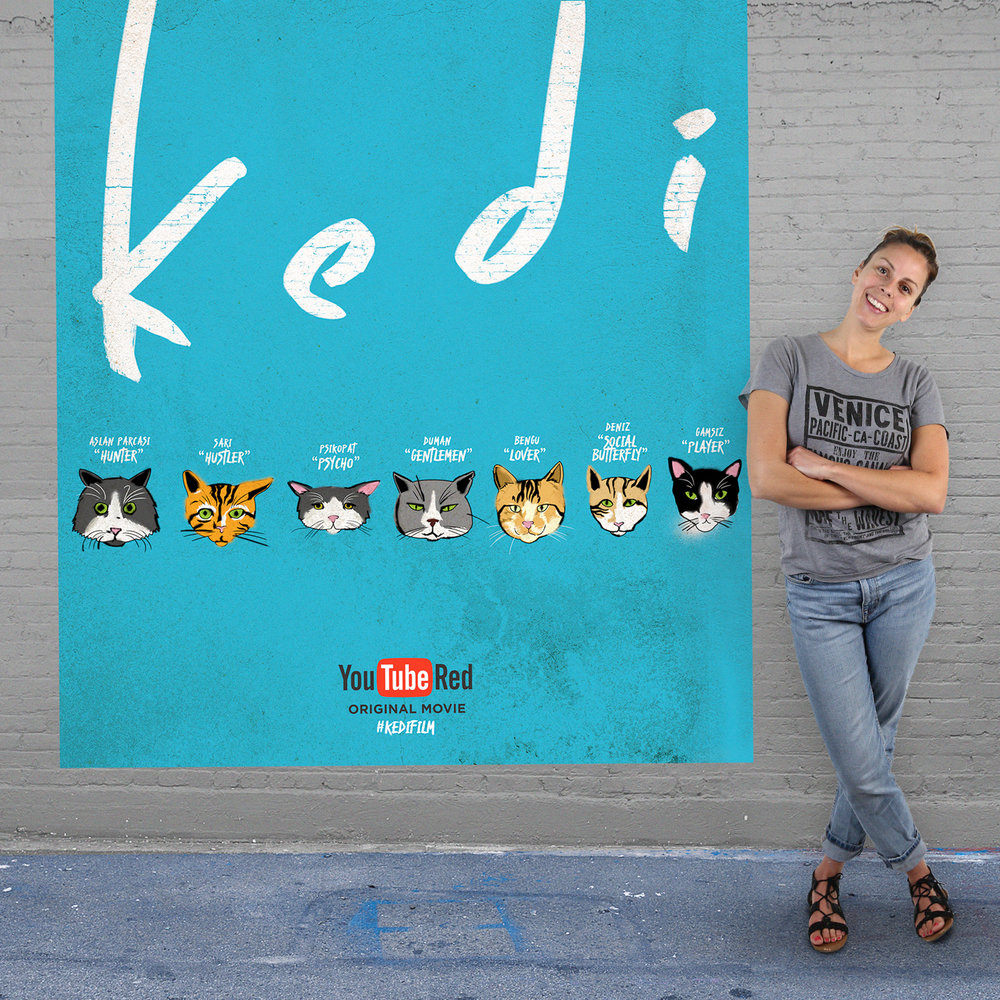Our Dutch distributor Cinema Delicatessen have designed a great website for the film. And you even get to make your own Kedi Poster. Simply upload an image of your cat and there you go. Click here to get to the website.
Take the Meowers-Briggz Purrsonality Test
10 questions will determine your personality type.
Are you a hustler? Player? Lover?
WHAAAT? Thrillist rates Kedi to be best doc in 2017 (so far)
Of course we feel incredibly honored that Thrillist loves the cats ....
1. Kedi
Released: February 10
Director: Ceyda Torun
Why it’s great: Offering a one-of-a-kind encounter of Istanbul through its feline inhabitants, Kedi is part travelogue, city symphony, nature film, and feature-length cat video. Whimsically shot mostly at street level, the doc occasionally lifts its perspective to allow humans to speak for the freewheeling animals, explaining their general history and significance as well as offering specific introductions and stories. But the movie's stars are the four-legged creatures who roam wild, yet are still well-cared for by citizens willing to leave out food or pay vet bills. Even if you're not a cat person, you'll find Kedi an enchanting and tranquil delight. A tense and thrilling fight scene can't possibly be beaten by any of this year's action movies.
Kedi’s cats are taking over Brooklyn!
We’ve got larger than life cats roaming the streets waiting for you right now.
If you're local, follow the "Cat Tour" and share your selfies using #KEDIfilm.
Too far away while the cats play?
Here are the Kedi murals in Brooklyn for those of you who don't live close enough to walk up and snap a pic.
Cats and the city: 'Kedi' investigates the feline lives of Istanbul
Our review from Kenny Turan at the Los Angeles Times!
“Kedi” means cat in Turkish. And while you don’t have to be crazy about cats to enjoy this documentary, it would certainly help.
As that Turkish title indicates, “Kedi” is shot on the streets of modern Istanbul, with director Ceyda Torun, who was born in the city, and her intrepid cameraman and co-producer, Charlie Wuppermann, investigating the antics of half a dozen or so frisky felines.
Street cats, unowned and on their own, have been a feature of Istanbul life for uncounted centuries, and according to “Kedi” their presence “embodies the indescribable chaos, the culture and the uniqueness that is the essence of Istanbul. Without them, the city would lose part of its soul.”
Torun intended the film as “a love letter to those cats and the city.” And one of “Kedi’s” virtues is the picture it provides of modern Istanbul, giving us a dawn-to-dusk tour of the metropolis and showing us neighborhoods that feel very much like the real, everyday Istanbul, not the tourist mecca we usually see.
Mostly, though, we see cats, engaging in all manner of species-appropriate activities: running, foraging, harassing mice, crawling in and out of tight spaces, accessing inaccessible ledges, taking cat naps, engaging in cat fights, etc.
Though Wupperman, who filmed in Istanbul for two months, has done a remarkable job getting down to cat level and following the animals around, even using a bit of infra-red technology to follow one cat on the hunt for a mouse, unless you are a devoted feline fancier the film’s brief 79-minute length will not seem too short.
Adding interest are the humans who, for a variety of reasons, both respect and look after these animals, giving them their freedom but helping to ensure that they don’t starve to death.
One woman admires cats because “they have the femininity that women have lost,” while another says that a relationship with a cat is like “being friends with an alien.”
One man says that “people who don’t love animals can’t love people either,” while another tells an elaborate story of how a cat guided him to a lost wallet with just the amount of money he needed for an essential repair.
Perhaps the most interesting response to cats was a theological one, with one person offering the following analysis:
“Dogs think people are God, but cats don’t. Cats are aware of God’s existence. Cats know that people act as middlemen to God’s will. They’re not ungrateful, they just know better.”
Though all the cats have names, and some even get flattering close-ups, the truth is that despite the protestations of the humans who insist each particular animal has a distinctive personality, on camera they all tend to run together after awhile.
By the time “Kedi” puts these animals through their paces, only one essential question remains unanswered: Will the dogs of the Dardanelles demand equal exposure? This could be a trend.
Review: Cute Cats of ‘Kedi,’ Rekindling a ‘Love of Life’
Our amazing New York Times review by Glenn Kenny:
If I correctly recall whatever cat domestication lore I’ve absorbed over the years, the creatures we now sometimes refer to as “house cats” were tolerated because they were quite useful. Cats, for instance, would keep rodents away from granaries. They were cared for by humans, but not coddled, maintaining a certain measure of independence. The street cats of Istanbul, who would probably be considered an animal-control problem in the United States, are, in a sense, throwbacks to those ancients.
“Kedi” (“Feline”), a frequently enchanting documentary directed by Ceyda Torun, showcases some of these feline personalities and the humans who look after them. There’s a good deal of projection in the verbal accounts of the animals’ lives, but the movie, with its mobile camera low to the ground or looking down at cat-navigated rooftops, doesn’t do much to contradict the indirect anthropomorphizing. There’s a lot of action at piers and fish markets.
One restaurant cat earns its love old-school style, by snaring vermin. Another is so meek (or haughty, depending on how you look at it) that it never enters the high-end delicatessen it’s made its home, but signals frantically at the window when it’s hungry. The movie is replete with ingeniously constructed mini-narratives, including a turf war. The mesmerizing score by Kira Fontana, interspersed with well-chosen Turkish pop, is a real asset.
The movie hits a somber note near the end, noting that Istanbul’s modernization is crowding out both individuated neighborhoods and cats. The animals, one human says, can “rekindle our own slowly dying love of life.” That’s one way of putting it, I guess. In any event, I give “Kedi” four claws up.
NYT Critics’ Pick
Tracking the Street Felines of Istanbul, 'Kedi' Reveals a City’s Humanity
Another great review, this time from Bilge Ebiri at the Village Voice:
"A cat meowing at your feet, looking up at you, is life smiling at you," says one of the interviewees in Kedi, and who am I to argue? Ceyda Torun's daydream-like documentary explores a subject near and dear to my heart: the street cats of Istanbul, those countless, fearless denizens of Turkey's biggest, most bustling metropolis. Anyone who's visited the city has probably noticed that they're everywhere you look, fed and cared for by small networks of waiters, bakers, grocers, shopkeepers, wandering merchants, and tourists. Years ago, when I used to go back to Turkey more frequently, I would always check in on a couple of felines on a particular road in Beyo?lu. I did this not because I was a cat person, although I would eventually become one, but because it provided a sense of continuity in a city that otherwise seemed ever-changing and impossible.
Torun's film lovingly conveys that idea — that the cats of Istanbul help humanize and make sense of an uncontrollable place. She follows a number of cats as they make their way through their respective 'hoods, and by "follow" I mean she literally follows them, her camera low and gliding smoothly behind them, close to the ground, as if they had their own little kitty Steadicam and boom mic operators. Some are layabouts. Some are insistent foragers. Some just want to be petted. One spends all day catching mice at a seaside fish restaurant. Torun matches those close shots of the streets with aerial footage of the city itself, hovering over Istanbul's quilt-like expanse of roofs in every conceivable architectural style.
The director also spends some time interviewing the cats'...well, "owners" isn't exactly the right word, is it? But the kitties of Istanbul do have their human associates, the people who feed them, watch out for them, and take care of them when they're sick. Indeed, more than anything, the film is about these relationships. We understand that these folks need these cats as much as, or perhaps more than, the cats need them. We don't learn much about these caretakers, though a few background details and cutaways give us clues: an antiques store here, a fisherman's boat there, a baker's oven there. An interviewee tells us how she only found the way toward healing her own wounds by healing the cats around her. Another talks about how the cats allow her to find some sense of calm and hope amid the chaos of life. "They remind us that we're alive," another says.
There's something missing here, however, though I think it's been deliberately hidden. Torun's film offers little sense of the current political reality of Istanbul, a city that's been racked by terror attacks and protests and that is, in effect, at war with itself. You could argue that Kedi seeks a more timeless approach. There's very little politics or history of any sort to be found in the film. One interviewee does speculate about why there are so many cats of such diverse breeds in one particular part of the city — they probably came off the many boats sailing through the Bosphorus — but that's about it. (I don't blame Torun for not getting too deep into the history, because otherwise she'd also have to reckon with the fact that more than a century ago, Istanbul, then known as Constantinople, was famous for its stray dogs; what happened to them is a sad, shadowy tale I won't get into here.)
But conflict and unrest have always defined Istanbul, and if you look closely enough, these forces do seem to be lurking somewhere beneath the film's placid surface. One interviewee talks about the death of the city's parks, which may evoke for some the Gezi Park uprising of 2013. Those protests initially erupted over the government's decision to level one of the city's remaining green spaces to make way for a giant, garish shopping complex. We're told of steel-and-glass buildings going up and changing the city, pushing the cats (and, let's face it, also the people) out. There are those right now who wish to turn Istanbul into a variation on Dubai, all shopping centers and office complexes and alt-brutalist shrines to money and power. And guess what? They're not big on stray cats in Dubai.
Kedi stands as a subtle, gentle rebuke to such politico-architectural folly. And by showing the citizens of this troubled city at their most generous, it suggests that a social fabric that often seems like it's rapidly fraying — at least to many of us now on the outside — endures. There is a part of me that wishes Kedi had more context, that it further clarified and spelled out some of the threats facing this beautiful city and its people. But in its own pleasantly dreamy and lilting way, the film embodies what it preaches: As life gets rougher, people endure not by hardening themselves even further, but by continuing to find the freedom to be kind. In Istanbul, the chaos never really stops. Kedi slyly reminds us that the humanity, too, has always been there.
Critics' Pick
‘Kedi’ is the ‘Citizen Kane’ of Cat Documentaries — Review
An amazing review from Eric Kohn, deputy editor of Indiewire:
If Grumpy Cat is the blockbuster franchise of cat videos, “Kedi” is the “Citizen Kane” of the genre. Though technically a sophisticated, artful documentary from Turkish filmmaker Ceyda Torun, “Kedi” will automatically find devout fans among anyone who delights at all things feline. (I’m an unapologetic member of that club.) Shot throughout the streets of Istanbul, the movie takes the inherent appeal of its subject and goes beyond the call of duty.
Cat lovers may be content with a mashup of feline faces bounding around the city, but hell, YouTube’s got that covered. “Kedi” isolates the profound relationship between man and cat by exploring it across several adorable cases in a city dense with examples. The result is at once hypnotic and charming, a movie with the capacity to elicit both the OMG-level effusiveness of internet memes and existential insights. Torun interviews a variety of locals about their bonds with the creatures, but the cats themselves take center stage, transforming the experience into a spiritual meditation on their significance to modern civilization.
“Kedi” — the name is Turkish for you-know-what — opens by explaining the role of stray cats in Turkish culture for thousands of years, but thankfully wastes no time with a complex history lesson. Torun dives into a montage of cats wandering the jagged urban landscape, daintily stepping across balconies and rooftops like an eternal Greek chorus bearing witness to the endless march of time.
It also doesn’t take too long to capture the sweet, enchanting qualities that leave so many of us smitten with these remarkable creatures: the nimble movements that seem to follow some kind of natural musicality, those colorful eyes rich with elusive meaning, a sense of individuality matched with a curiosity around the prospects of companionship…these are chief ingredients that reduce many of us to states of monosyllabic ecstasy, and they’re the visual building blocks that keep “Kedi” engaging over the course of its concise 75-minute length.
Torun compliments the movie’s visual appeal with surprisingly thoughtful observations from the various locals who discuss the cats throughout. The earliest montage is a symphonic celebration of the cats wandering Istanbul that recalls the Gershwin-spiced opening of Woody Allen’s “Manhattan.” As vibrant Turkish folk plays on the soundtrack, one subject remarks that “without the cat, Istanbul would lose its soul.” By showing how the cats interact with the city’s every crevice, “Kedi” leaves no doubt about that.
Cats have held appeal for filmmakers since the earliest days of the moving image (Thomas Edison recorded them boxing in an 1894 short), and “Kedi” does a terrific job of burrowing inside their worlds. Torun’s camera often stays at their level, darting through alleyways, late night rat battles, and feasts of anchovies provided by generous fisherman. But she just as often reveals the remarkable impact these creatures have on a wide array of people, who help the animals sustain their paw-to-mouth plights out of a duty they can only partially comprehend.
It’s possible that they’re compelled by just how much cats look like people. “Some cats have character,” says one subject. “You can tell from their faces.” Torun emphasizes that remark with recurring closeups of her subjects, even isolating a handful of recurring characters. There’s Duman, the glutton, who hangs out at a classy deli and scratches the window when he’s hungry, forcing butchers to put him on a diet, and “Little Lion,” a ferocious mouse-killer who earns his keep at an upscale fish restaurant, and several others. If Disney wanted to think outside the box for an upcoming project, transforming this world into an animated musical wouldn’t be such a far-fetched concept. These cats don’t speak, but they’re so expressive you can hear them anyway.
Nitpicking viewers might shrug off “Kedi” for lacking a precise narrative thread, as it veers from one cat profile to another, but Torun keeps the movie flowing along with compelling observations every couple of minutes. The cosmic perspective strikes a noticeable contrast to other modern cat documentaries (the two-part PBS series “The Story of Cats” comes to mind), which tend to favor the scientific approach. Instead, “Kedi” is a playful and poignant look at the complex nature of the creatures and their inherent appeal to humankind. It’s also unapologetically biased. “People who don’t like animals,” remarks one fisherman, “don’t like people.”
Some may take umbrage at that blanket statement, but it’s a testament to the intense allure of cats that enthusiasts regard as pure fact. Whether or not cats themselves care about this intense affection is beside the point — or easy enough to explain away. One savvy Turk argues that cats are more cognizant of a higher being governing their world, which explains their general sense of ambivalence toward people. But “Kedi” is ultimately a movie about a mystery. It’s impossible to fully explain how cats and people truly connect, considering their lack of a shared language. One interviewee argues that the relationship between cats and people is the closest we might get to understanding what it’s like to interact with aliens. If so, “Kedi” goes a long way towards making first contact. Then again, dog people may find themselves in the dark.
Grade: A-
Cat-leidoscopes!
Celebrate your favorite feline with their very own Cat-leidoscope. Here's how to enter for a chance to get one:
Share a head shot of your cat on social media. The more of the frame your cat’s face takes up, the better. No blurry images please. Quality counts! For Instagram and Twitter be sure to tag #KediFilm and for Facebook simply post your cat photos to our official KEDI page.
If your cat's photo is selected, we'll send you a direct message with the goods so you can post it to your heart's content.
Variety: A Magical and Remarkable Documentary
A magical and remarkable documentary about the free-roaming feline population of Istanbul.
Early in “Kedi,” Ceyda Torun’s splendidly graceful and quietly magical documentary about the multifaceted feline population of Istanbul, a human inhabitant of the city notes: “Dogs think people are God, but cats don’t. Cats know that people act as middlemen to God’s will. They’re not ungrateful. They just know better.” All of which might explain why so many of the movie’s four-legged subjects come across not as feral orphans who rely on the kindness of strangers, but rather as slumming royals who occasionally deign to interact with two-legged acolytes.
Indeed, another interviewee here swears that, after his fishing boat was damaged during a storm, a beneficent cat led him to a lost wallet containing just enough money to pay for repairs. “Whoever doesn’t believe this story,” the grateful beneficiary proclaims, “is a heathen in my book.”
Trust me: “Kedi” will make you a believer.
Torun, a Turkish-born filmmaker now based in the United States, and cinematographer Charlie Wuppermann, her partner in the production company Termite Films, take their audience on a leisurely yet purposeful journey throughout Istanbul (where Torun was raised) to examine a local phenomenon dating back to the heyday of the Ottoman Empire: Thousands of cats roam freely virtually everywhere and anywhere, peacefully co-existing with humans who learned long ago not to assume they are the masters in this situation.
Most of the felines are strays, proudly independent but more than willing to accept food and favors (and, more important, attentive petting) from the humans they choose to “adopt.” In turn, the humans — men, women, and children of all ages and backgrounds — admire and accept the autonomy of the cats. Even those who routinely feed, groom, and occasionally fret over the four-legged vagabonds who wander in and out of their lives respect the animals’ privacy — and freely admit that humans aren’t the only ones who benefit from this symbiotic relationship. “They absorb all your negative energy,” a shopkeeper says of the cats who sporadically show up at her door. “They do me good.”
Another interviewee claims that petting a cat can be as spiritually soothing as fingering prayer beads. But take care. “If you pet another cat,” he says while referencing his frequent guest, “she’ll get jealous and sulk.” Another problem to consider: As ambitious construction projects change the face of Istanbul, cats are displaced from their lairs whenever old buildings, or entire neighborhoods, are eliminated.
Cats are praised for everything from their therapeutic value to their usefulness as mousers throughout “Kedi.” But these heartfelt testimonials, delivered largely by unnamed admirers, don’t take up nearly as much screen time as footage devoted to the cats themselves. Lengthy, loving closeups alternate with remarkably fluid tracking shots as Torun and Wuppermann consider the elegant poise, casual indolence, and gritty resourcefulness of cats (and their kittens) going about their everyday lives.
The beautifully spare musical score by Kira Fontana provides the perfect accompaniment for what gradually emerges as a profoundly affecting meditation, at once dreamy and precise, on a force of nature — several forces of nature, actually, with paws and tails — surviving and thriving in an industrialized world.
Screenhub: The Ultimate Cat Video
“Without the cat, Istanbul would lose part of its soul,” one of the city’s residents advises in the opening minutes of Kedi. His statement may sound like the expectedly fond fawning of a feline fancier; however it is actually a reflection of life at street level in Turkey’s most populous centre. As people go about their days, so does a sizeable contingent of meowing creatures, continuing a tradition of roaming freely through the ancient metropolis that dates back thousands of years.
On the pavement, they scurry in search of food. Loitering outside of cafes, they warm to coffee-sipping clientele. Many stalk around the upper reaches of buildings, staring down at the movement below them. One sleeps on a canvas awning above a fishmonger’s storefront, descending at an opportune moment to battle the birds for scraps. Another keeps a seaside restaurant free from rodents by night, then rests on a rocky platform by the shore by day. Yet another still climbs a tree to access the balcony of an apartment inhabited by another cat. Proving hungry but polite, another paws at the window of a deli looking for gourmet cheese and meat, yet won't enter the premises.
Every animal is an individual, and is treated as such. And just as no tabby's tale is the same as the other selected specimens of its species, neither is the film's approach to Bengü, Deniz, Duman, Gamsiz, Rat Catcher, Yellow and Psycho's stories. As guided by debut feature director Ceyda Torun (short Consuming Love), cinematographers Alp Korfali (Baskin) and Charlie Wuppermann (A Country Called Home) capture the cute, chaotic and curious scenes of cat activity from an array of angles. Sometimes, the crisp imagery peers down from above, or takes a moment to gaze into the faces of the movie's stars. Often, it watches the critters’ fluid movements from a human’s viewpoint — and, just as frequently, it weaves hand-held and cat-mounted cameras underneath tables, up and down walls, and along the ground for a kitty's-eye vantage.
Accordingly, as littered with slivers of historical and cultural information, Kedi strives to capture just what it is like to be one of the thousands of mousers in Istanbul today, particularly as the city endeavours to usher in a new era of redevelopment in areas typically plentiful with furry, four-legged friends. More than that, the documentary imparts an informative, endearing and amusing chronicle of everyday existence for the kindly folks that come into each animal's orbit. And, as the two perspectives combine in every revealing vignette, as perceptively edited together by Mo Stoebe (State of Control) and set to the playful, authentic music of first-time film composer Kira Fontana, they provide a portrait of not only co-existence, but of the bustling locale around them.
Indeed, while many an online clip has demonstrated the instant entertainment that can result from simply pointing a camera in a cat’s direction and watching it go about its daily business, Kedi splices the usual emotional reaction such antics garner with an ethnographic-like mission. Affection radiates from the documentary, but so does an insight into why a purring, prowling kitty can evoke such a response. Though no definitive answer arises, the feature's joyous attitude, relaxed pacing and freewheeling structure offers the closest approximation it can. Yes, Kedi is an unashamed love letter to the compelling creatures at its centre, but, peppered with wisdom and warmth, it's also more than just the ultimate cat video.
Rating: 4 stars out of 5




